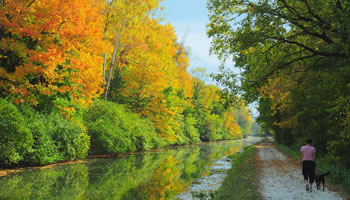Supply and Sources
Citizens water supply comes from several sources, utilizing both surface water and groundwater. Surface water comes from rivers, creeks, streams and reservoirs. Groundwater comes from below the surface. It originates from rain, snow, sleet and hail that has seeped into the ground. This water collects in pockets underground between sand, gravel or pores.
Citizens has four surface water treatment facilities that provide a majority of Citizens’ water supply: White River, White River North, Fall Creek and T.W. Moses.
Three reservoirs assure a dependable water supply to these treatment plants:
-
Morse Reservoir, near Noblesville, stores water to assure a dependable water supply for White River. Subsequently, it assures proper water supply to the White River and White River North Treatment Plants.
-
Geist Reservoir, in the northeastern portion of Marion County, stores water to assure a dependable water supply for Fall Creek and proper water supply for the Fall Creek Treatment Plant.
-
Eagle Creek Reservoir supplies surface water to the T.W. Moses Treatment Plant.
A number of wells are available to supplement the supplies to the White River, White River North and Fall Creek treatment plants.
Citizens has five groundwater stations that serve smaller portions of our service area: Geist Station, Harding Station, South Wellfield, Harbour and Ford Road. These groundwater stations treat water pumped from underground water sources called aquifers.
Central Canal

Built between 1836 and 1839, the Indiana Central Canal is now an important part of the water supply of Indianapolis. Starting in Broad Ripple just south of 64th Street, the Canal moves water from the White River about 6.5 miles to Citizens White River Treatment Plant off 16th Street just west of downtown. The downtown section of the Canal from 11th to the White River, which is owned by the City of Indianapolis, is not part of the water supply system. Home to the Central Canal Towpath, a popular bike and pedestrian trail, the canal is an important part of the history and culture of central Indianapolis.
History of the Canal
The Indiana Central Canal was a canal intended to connect the Wabash and Erie Canal to the Ohio River. It was funded by the Mammoth Internal Improvement Act. The canal was funded with $3.5 million from the $10 million Mammoth Internal Improvement Act, Indiana’s attempt to take part in the canal-building craze started by the Erie Canal. However, due to the Panic of 1837, Indiana suffered financial difficulties and had to turn over the canal to the state's creditors, and building of the canal was stopped in 1839. The canal was supposed to extend 296 miles, from Peru, Indiana to Evansville, Indiana, where it would reach the Ohio River. It was originally divided into two sections, North and South. Later, a third section was designated, called the Indianapolis section. Only eight miles were completed, with eighty additional miles between Anderson, Indiana and Martinsville, Indiana, having been partially built.
Prior to its construction, the canal path was surveyed by Jesse Williams, the canal engineer of Indiana. The state of Indiana already owned most of the land required for the canal. The canal was six-feet deep and sixty-feet wide.
The eight fully completed miles were entirely within the Indianapolis section, continuing to parallel the White River. This section consisted of 24 miles dug and watered from Waverly, Indiana to Broad Ripple, where the construction began. Because the land was undeveloped, construction between Broad Ripple and downtown Indianapolis was difficult. In the last half of the 19th century, various water companies used the section to power pumps for the water system in Indianapolis, which used purified well-water and not canal water. In 1904 the Indianapolis Water Company (IWC) finally took advantage of the partially built canal as a source for a purification plant. In the late 1960s, construction of Interstate 65 forced a section of the canal underground and by 1969, the IWC ceased using it as a source of power for its West Washington Street pumping station. Subsequently, in 1976 the IWC deeded the canal south of 16th Street to the City of Indianapolis. The City later undertook a project, beginning in 1985, to drain, rebuild, lower and then restore water to the remaining downtown section of the canal. Some of that portion of the Central Canal is now within White River State Park, as well as running through the Indiana Government Center.
The Central Canal Towpath of Indianapolis follows along a portion of the completed eight miles. It runs from Broad Ripple to 30th Street near Riverside Park and goes by Butler University and the Indianapolis Museum of Art.
Six different species of turtles populate the Indianapolis section, and are studied to see how urban environments affect wildlife.
The southern section was from Port Royal (now Waverly) to Evansville. It was primarily surveyed by Francis Cleveland. The 20 miles attempted were in Vanderburgh and Warrick counties.
In 1971, the canal was designated by the American Water Works Association as an American Water Landmark.
For more information on the history of the Central Canal and other Indiana canals, please visit the Canal Society of Indiana.
Canal Projects
Various community groups periodically propose improvement projects along the Canal. Citizens reviews each proposal in keeping with the ![]() Canal Policy.
Canal Policy.
As always, our primary goal is to preserve the operational integrity of the canal while acknowledging the cultural and historic significance it has for the neighborhoods along its banks. Links to formal canal project proposals from community organizations will be posted on this page.

